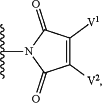| CPC C09K 19/2028 (2013.01) [C08G 73/10 (2013.01); C08G 77/045 (2013.01); C09K 19/02 (2013.01); C09K 19/3483 (2013.01); B82Y 20/00 (2013.01); C08G 2250/00 (2013.01); C09K 2019/0448 (2013.01); C09K 2019/2078 (2013.01); C09K 2219/03 (2013.01)] | 23 Claims |

|
1. A polymerizable mixture comprising a first monomer and a second monomer,
wherein the first monomer is one or more compounds of Formula (1):
P1-Sp1-(MG-Sp1)m-P1 Formula (1)
wherein:
m is an integer of 2 to 60;
P1 denotes
 V1 is H;
V2 is alkyl with 1 to 6 carbon atoms, F, Cl or CN;
or
V1 and V2 are independently of one another alkyl with 1 to 6 carbon atoms, F, Cl or CN;
Sp1 denotes at each occurrence Sp′-X′;
Sp′ denotes
(a) a straight chain alkylene having 1 to 40 C atoms or branched chain alkylene having 3 to 40 C atoms, which is optionally mono- or polysubstituted by F, Cl, Br, I or CN and in which one or more non-adjacent CH2 groups may each be replaced, independently of one another, by —O—, —S—, —NH—, —NR01—, —SiR01R02—, —CO—, —COO—, —OCO—, —OCO—O—, —S—CO—, —CO—S—, —NR01—CO—O—, —O—CO—NR01—, —NR01—CO—NR01—, or —CH═CH— in such a way that O and/or S atoms are not linked directly to one another, or
(b) -Spx-G-Spy-, wherein SpX and Spy denote independently of each other alkylene having 1 to 20 C atoms or a single bond; G denotes cycloalkylene having 3 to 20 C atoms which is optionally mono- or polysubstituted by alkyl having 1 to 20 C atoms;
X′ denotes —O—, —S—, —CO—, —COO—, —OCO—, —O—COO—, —CO—NR01—, —NR01—CO—, —NR01—CO—NR01—, —OCH2—, —CH2O—, —SCH2—, —CH2S—, —CF2O—, —OCF2—, —CF2S—, —SCF2—, —CF2CH2—, —CH2CF2—, —CF2CF2—, —CH═N—, —N═C—, —N═N—, —CH═CR01-, —CY11═CY12-, —C═C—, —CH═CH—COO—, —OCO—CH═CH— or a single bond;
Y11 and Y12 each, independently of one another, denote H, F, C or CN;
MG is a rod-shaped mesogenic group of Formula (2):
-(A21-Z21)k-A22-(Z22-A23)l- Formula (2)
A21 to A23 are independently and at each occurrence independently of one another an aryl group, heteroaryl group, heterocyclic group, alicyclic group or cyclic imide group optionally substituted by one or more identical or different groups L;
Z21 and Z22 are independently and at each occurrence independently from each other, —O—, —S—, —CO—, —COO—, —OCO—, —S—CO—, —CO—S—, —O—COO—, —CO—NR01—, —NR01—CO—, —NR01—CO—NR02, —NR01—CO—O—, —O—CO—NR01—, —OCH2—, —CH2O—, —SCH2—, —CH2S—, —CF2O—, —OCF2—, —CF2S—, —SCF2—, —CH2CH2—, —(CH2)4—, —CF2CH2—, —CH2CF2—, —CF2CF2—, —CH═N—, —N═CH—, —N═N—, —CH═CR01—, —CY01═CY02—, —CH═CH—COO—, —OCO—CH═CH—, or a single bond;
R01 and R02 each, independently of one another, denote H or alkyl having 1 to 12 C atoms;
L is F, Cl, Br, I, —CN, —NO2, —NCO, —NCS, —OCN, —SCN, —C(═O)NRxxRyy, —C(═O)ORxx, —C(═O)Rxx, —NRxxRyy, —OH, —SF5, or straight chain alkyl, alkoxy, alkylcarbonyl, alkoxycarbonyl, alkylcarbonyloxy or alkoxycarbonyloxy with 1 to 20 C atoms, or branched chain alkyl, alkoxy, alkylcarbonyl, alkoxycarbonyl, alkylcarbonyloxy or alkoxycarbonyloxy with 3 to 20 C atoms, wherein one or more H atoms are optionally replaced by F or C, —CN or straight chain alkyl, alkoxy, alkylcarbonyl, alkoxycarbonyl, alkylcarbonyloxy or alkoxycarbonyloxy with 1 to 6 C atoms, or branched chain alkoxy, alkylcarbonyl, alkoxy-carbonyl, alkylcarbonyloxy or alkoxycarbonyloxy with 3 to 6 C atoms;
Rxx and Ryy independently of each other denote H or alkyl with 1 to 12 C-atoms;
Y01 and Y02 each, independently of one another, denote H, alkyl having 1 to 12 C atoms, aryl, F, Cl, or CN; and
k and l are each and independently 0, 1, 2, 3 or 4;
and
wherein the second monomer is one or more bi- or multifunctional compounds capable of reacting with the first monomer to give a copolymer, wherein the one or more bi- or multifunctional compounds comprise two or more polymerizable groups (P) which are selected from groups containing a C═C double bond, groups containing two conjugated C═C double bonds, nucleophilic groups, and 1,3-dipolar groups.
|